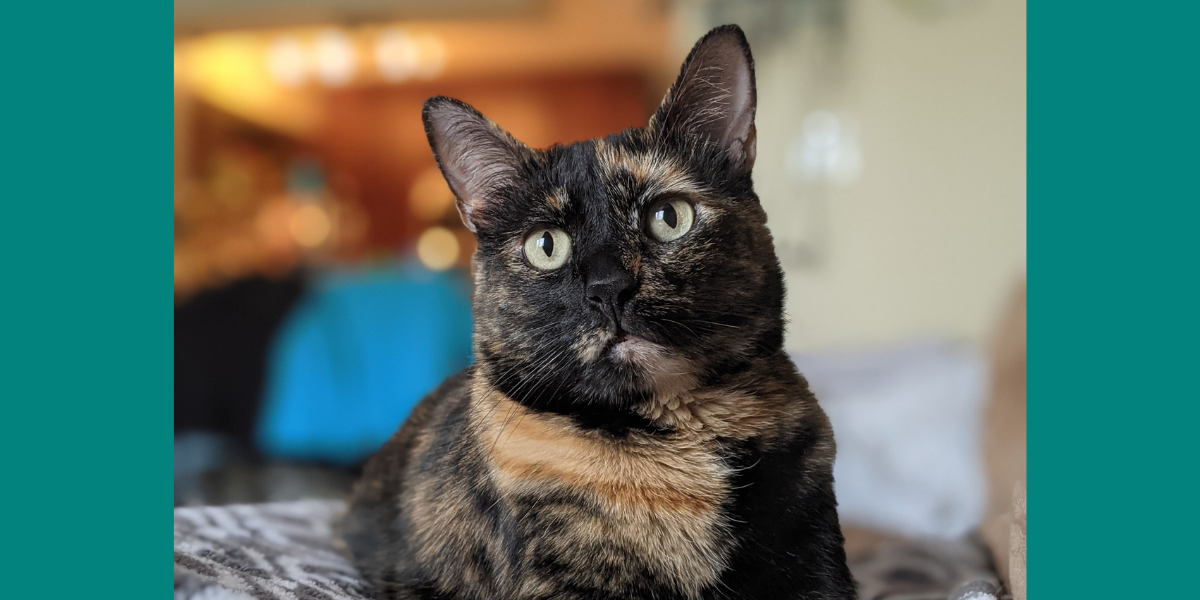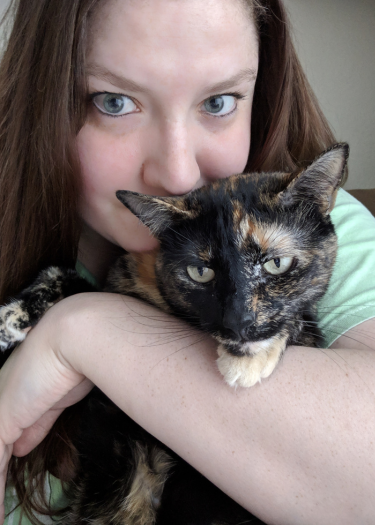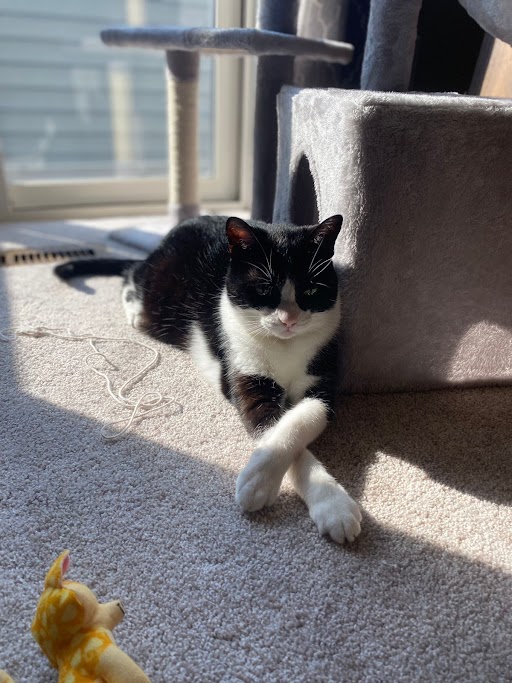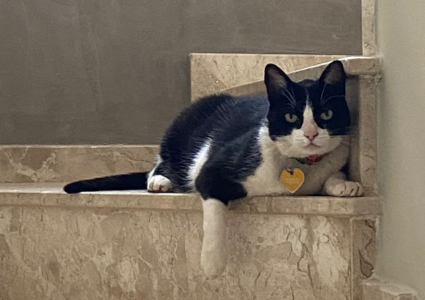Imagining a pain-free future
A clinical trial is paving the way for a new treatment for cats with osteoarthritis—and it hits close to home for CVM researchers.

A clinical trial is paving the way for a new treatment for cats with osteoarthritis—and it hits close to home for CVM researchers.
Finley the cat is part of a clinical trial that is testing a new painkiller aiming to bring relief to cats diagnosed with osteoarthritis.
Lindsay Knoll adopted Finley as a 12-week-old kitten. “She was my little rebellion,” Knoll says, “because my mom had said ‘You can’t adopt a kitten in college!’” Twelve years later, Finley and Knoll have been through a lot together—and Finley has started to show her age.
When Finley was about 10, Knoll noticed a limp in her front leg.
“I assumed maybe she jumped on it funny or something,” she says. But it turned out to be the beginning of osteoarthritis.
Osteoarthritis (OA) is a degenerative disease where cartilage—the cushion between the bones in a joint—breaks down, leaving the bones to rub together. This rubbing can damage the joint and cause pain, inflammation, swelling, and decreased range of motion. OA affects many mammal species, including humans, horses, dogs, and even dolphins. In cats, osteoarthritis prevalence increases with age, becoming very common in the geriatric population.
Within a year of her diagnosis, Finley’s OA had gotten “really bad,” Knoll says. “Especially after laying down you could tell she was really stiff—limping, not wanting to jump on the bed or couch—and it came on fairly fast.”

To address her pain and stiffness, Finley takes three medications, including a once-per-month injectable. “It helps a little,” Knoll says.
As fate would have it, during this same period, Knoll started the Masters in Veterinary Sciences program at the College of Veterinary Medicine (CVM), where she joined the lab of Alonso Guedes, professor in the Department of Veterinary Clinical Sciences. Guedes’s research focuses in part on pain management, and he was beginning a clinical trial of a new medication to treat feline osteoarthritis.
“In this study, we are testing a new medication that, based on previous research, we think may help decrease pain while also improving the overall health of the joint,” Guedes says. “There currently are no other medications for osteoarthritis that can do both of these things."
Not only was the study a perfect fit for Knoll to take on as her master’s project, but it was also the perfect opportunity for her to enroll Finley as a participant.
The study evaluates whether a new painkiller (EC1728) can provide relief for cats with OA. After an initial screening, physical, and lab work, participants are fitted with a pedometer collar—a “kitty Fitbit,” describes Knoll—to measure their activity. They take EC1728 for one week, and a placebo for one week, with two weeks after each to clear their systems of the drug. Owners don’t know which week is the drug week and which is the placebo, and they fill out several questionnaires over the course of the study to assess their cat’s behavior.
“Finley may never go back to being completely pain-free,” Knoll says, “but if this therapy proves effective, being able to give her just one medication instead of three would be much easier and less expensive.”

Finley isn’t the only CVM cat to participate in the trial. Eduardo Hatschbach, a postdoctoral researcher working on another project in Guedes’s lab, also heard about the trial and enrolled his cat Crystal.
At 17, Crystal’s life has spanned two decades and two continents. She was found in a cemetery in Hatschbach’s native Brazil, and he adopted her when she was 2 months old. Along with his two Yorkshire terriers Jolie and Kourtney (nicknamed Gordinha, or “Little Fat” in Portuguese), he moved Crystal to the U.S. in 2022 to start his postdoc at CVM.
“She’s such a good cat, so nice and friendly, and she’s always been very healthy,” Hatschbach says. But in recent years, she had been showing signs of OA. For example, “she used to jump into the sink to drink water in the bathroom, but she stopped doing that. She was always asking for us to pick her up and put her there.”

When Hatschbach heard about the trial, he thought Crystal might benefit. She received an official diagnosis of OA when she was assessed to determine her eligibility for the study.
While her case is mild, Hatschach was still happy to participate in the study.
“I thought, OK, if it works, maybe down the line it could actually help her if she gets worse,” he says. “No matter what, I’m glad to help the research, to potentially help my cat and other cats have a better quality of life.”
If you are interested in participating in the feline osteoarthritis trial, please reach out to Lindsay Knoll at knol0091@umn.edu. The trial is run by the College of Veterinary Medicine’s Clinical Investigation Center (CIC). The CIC supports more than 40 clinical trials that may lead to new drugs, devices, procedures, and treatments.
For more information on this and other studies at the University of Minnesota College of Veterinary Medicine, please contact the Clinical Investigation Center at vcic@umn.edu or visit its website.